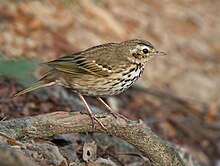ar
الأسماء في صفحات التنقل


The wagtails, longclaws, and pipits are a family, Motacillidae, of small passerine birds with medium to long tails. Around 70 species occur in five genera. The longclaws are entirely restricted to the Afrotropics, and the wagtails are predominantly found in Europe, Africa, and Asia, with two species migrating and breeding in Alaska. The pipits have the most cosmopolitan distribution, being found mostly in the Old World, but occurring also in the Americas and oceanic islands such as New Zealand and the Falklands. Two African species, the yellow-breasted pipit and Sharpe's longclaw, are sometimes placed in a separate seventh genus, Hemimacronyx, which is closely related to the longclaws.[1]
Most motacillids are ground-feeding insectivores[2] of slightly open country. They occupy almost all available habitats, from the shore to high mountains. Wagtails prefer wetter habitats than the pipits. A few species use forests, including the forest wagtail, and other species use forested mountain streams, such as the grey wagtail or the mountain wagtail.
Motacillids take a wide range of invertebrate prey: insects are the most commonly taken, but also including spiders, worms, and small aquatic molluscs and arthropods. All species seem to be fairly catholic in their diets, and the most commonly taken prey for any particular species or population usually reflects local availability.
With the exception of the forest wagtail, they nest on the ground,[2] laying up to six speckled eggs.
Wagtails, pipits, and longclaws are slender, small to medium-sized passerines, ranging from 14 to 17 cm (5.5 to 6.7 in) in length, with short necks and long tails.[2] They have long, pale legs with long toes and claws, particularly the hind toe, which can be up to 4 cm in length in some longclaws. No sexual dimorphism in size is seen. Overall, the robust longclaws are larger than the pipits and wagtails. Longclaws can weigh as much as 64 g, as in Fülleborn's longclaw, whereas the weight range for pipits and wagtails is 15–31 g, with the smallest species being perhaps the yellowish pipit.[3] The plumage of most pipits is dull brown and reminiscent of the larks, although some species have brighter plumages, particularly the golden pipit of north-east Africa. The adult male longclaws have brightly coloured undersides. The wagtails often have striking plumage, including grey, black, white, and yellow.
A molecular phylogenetic study published in 2019 sampled 56 of the 68 recognised species in the family Motacillidae and found that the species formed six major clades. The pipit genus Anthus was paraphyletic with respect to the longclaw genus Macronyx. The striped pipit (Anthus lineiventris) and the African rock pipit (Anthus crenatus) were nested with the longclaws in Macronyx.[4] The type species of Anthus, the meadow pipit, was nested with the other Palearctic species in Clade 2.[5][4]
MotacillidaeMotacilla – typical wagtails
Clade 4 - Anthus – large-bodied African species
Macronyx – longclaws – but includes golden pipit (Tmetothylacus tenellus) and yellow-breasted pipit (Anthus chloris)
Clade 3 – Anthus – striped pipit (Anthus lineiventris) and African rock pipit (Anthus crenatus)
Clade 2 – Anthus – Palearctic species
Clade 1 – Anthus – New World and small-bodied African species





Family: Motacillidae
The wagtails, longclaws, and pipits are a family, Motacillidae, of small passerine birds with medium to long tails. Around 70 species occur in five genera. The longclaws are entirely restricted to the Afrotropics, and the wagtails are predominantly found in Europe, Africa, and Asia, with two species migrating and breeding in Alaska. The pipits have the most cosmopolitan distribution, being found mostly in the Old World, but occurring also in the Americas and oceanic islands such as New Zealand and the Falklands. Two African species, the yellow-breasted pipit and Sharpe's longclaw, are sometimes placed in a separate seventh genus, Hemimacronyx, which is closely related to the longclaws.
Most motacillids are ground-feeding insectivores of slightly open country. They occupy almost all available habitats, from the shore to high mountains. Wagtails prefer wetter habitats than the pipits. A few species use forests, including the forest wagtail, and other species use forested mountain streams, such as the grey wagtail or the mountain wagtail.
Motacillids take a wide range of invertebrate prey: insects are the most commonly taken, but also including spiders, worms, and small aquatic molluscs and arthropods. All species seem to be fairly catholic in their diets, and the most commonly taken prey for any particular species or population usually reflects local availability.
With the exception of the forest wagtail, they nest on the ground, laying up to six speckled eggs.